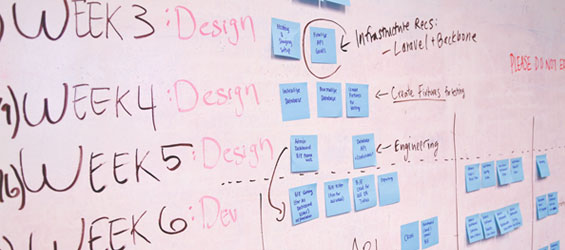

When embarking on a custom web design and/or development project, ask yourself which option feels more comfortable: flexible or fixed. Are you open to the possibility of new ideas emerging throughout the process or are you focused solely on a rigid timeline? Are you okay with a sense of the ballpark budget or set on a specific number?
While it’s not wrong to choose a fixed budget, we find that working on a flexible scope basis yields a better process, product and relationship. If your comfort level leans more toward a fixed budget, you’ll need to understand from the onset that there are concessions to be made – including no collaborative brainstorming as the project unfolds, no modifications or additions to the scope, and no way to increase or decrease the project timeframe.
Working Within a Fixed Budget
A completely fixed budget for a custom website project means that in order to guarantee that a project can be delivered in a specified amount of time, every nuance detail would need to be known upfront – essentially, you’d need to be able to predict the future, which is impossible. A few very basic things that we could never know at the onset of a project include:
- How may rounds of revision / iterations will each phase go through (Keyword Research, Sitemap/IA, Wireframes, Design, Production)?
- Will we receive assets in a timely manner, according to the milestones we’ve set?
- In what format will we receive content (even after specifying required format)?
- What issues / challenges might we run into during the project?
- What new opportunities may present themselves during the project?
- What additional work or requirements will be requested along the way?
Why We No Longer Draft Fixed-Cost Proposals
The initial intention of a fixed-cost proposal is to share the risk among both parties, but what ends up happening is that expectations are misaligned from the start – and new requests and requirements during the project cannot be included for the same budget [by the agency], but are expected to be [by the client]. It creates a false sense of security where everyone thought they were in agreement with the work that had to be done. And when they find out that expectations weren’t aligned, some clients even resort to finding loopholes in the scope of work to try to pressure the agency. The reason we no longer draft fixed-cost proposals is because any client that sees an evolving product will notice things that never would have come to light if a finite set of requirements had been used.
Why We Deliver Agile Estimates
By choosing to estimate and bill based on agile methodology, we avoid the limitations and potential pitfalls of a fixed budget. We allow for flexibility in what a client requires and a better chance at building something that provides our clients with competitive advantages. What we need now may not be what we need in 10+ weeks when the project is complete. It’s important to note that this doesn’t mean that we can’t manage the project to keep it within a certain budget, but it does mean that we and the client are in agreement that new ideas will arise – and we both may want to include those ideas in the project so long as we both understand that the project timeline will be extended and an estimate for the additional work will need to be provided.
What Our Clients Gain from Agile
- Shared risk and a sense of security and predictability
- Smaller payments throughout a project lifespan
- More flexibility in implementing new ideas
- A more collaborative and communicative process
- Focus on strategically solving more business challenges
- Highest quality product and efficacy / results
What We Gain from Agile As An Agency
- Shared risk and a sense of security
- Short and frequent billing cycles; Improved profit margin
- Coverage against risk and change of scope
- High morale, creativity and collaboration
- Fewer projects in the ‘icebox’

